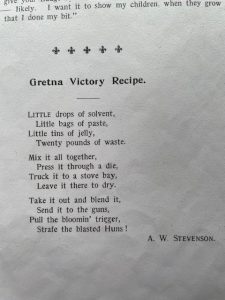
We’re delighted to share this blog written by Claudia Weyde-Bialas, who spent a week volunteering with us on curatorial projects.
In the course of my research for my thesis on “Self portrayal and (war) role perception in female munition workers’ poetry of World War I in Great Britain” last year, a very nice and helpful contact was established with the curator of the DPM and her team, who provided me with extensive documents and valuable additional information.
I found and find it very interesting that women poets of this era still receive little attention compared to their male counterparts. In particular, the lyrics of working-class women writers are not given the recognition they deserve, historically and culturally. Female munition workers, known as Munitionettes, who made up by far the largest proportion of the female workforce during WWI, published their verses and rhymes in factory magazines and staff journals, which now lie dormant in the archives of the Imperial War Museum in London. But the Devil’s Porridge Museum also has a considerable number of Munitionette poems and has published some of them in the volume Munition Workers’ Poems.

A Munitionette poem
During my research I decided to travel to Eastriggs and visit the DPM as soon as I had handed in my thesis. – I wanted to see the writings I was working on in the original and also get a personal impression of the research that was done at the museum.
I have now spent a week at DPM and have seen and learned a lot – I did not expect that. It is impressive how much ongoing research and projects are worked on behind the scenes, including the administration and inventory of the constantly growing collection of objects.
As well as getting to see “my” Munitionette poems, or at least some of them, I was allowed to work on the inventory catalogue and do research on people for the Miracle Workers Project. Especially the latter was super exciting, – you get a name and possibly a birth date of a worker at the Gretna factory and then you try to find out more about that person. Often you don’t find anything else, but then again you come across whole stories, and suddenly the people, the “Miracle Workers” come to life. This is a project that is really worth volunteering for!
I also chose an “Object of the month”, which is another ongoing project of the DPM. I picked a cameo brooch, and besides the fact that it was neither antique nor did it have any direct relation to the World Wars, it was – again – the story behind it that makes it special. The brooch belonged to a women who delivered telegrams in WWII, including those containing the death of a soldier. She gave the brooch to her nurse at the Annan hospital to thank her for her care, and the nurse donated it to the museum.
I think this is what history is about, it is about people and their stories. It is about “giving voice.” A museum can display valuable, rare and beautiful pieces in its showcases, but the true value of an object always comes from its story and the people associated with it. The DPM has realised that and that makes its exhibition and the work here special.
Last but not least, I would like to point out – in addition to the great research and administrative staff – the impressive number of volunteers who contribute to the very positive spirit of the facility with their constant friendliness and willingness to help.
THANK YOU!
By Claudia Weyde-Bialas
July 2022

